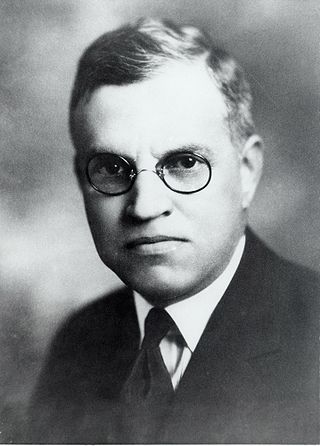
Robert Chambers Reamer (1873–1938) was an American architect, most noted for the Old Faithful Inn in Yellowstone National Park. A number of his works are listed on the National Register of Historic Places for their architecture.

The steamboat Ticonderoga is one of two remaining side-paddle-wheel passenger steamers with a vertical beam engine of the type that provided freight and passenger service on America's bays, lakes and rivers from the early 19th to the mid-20th centuries. Commissioned by the Champlain Transportation Company, Ticonderoga was built in 1906 at the Shelburne Shipyard in Shelburne, Vermont on Lake Champlain.

The Sheridan Inn is a historic hotel in Sheridan, Wyoming. Designed by the architect Thomas R. Kimball of Omaha, Nebraska in 1893, it was constructed by the Chicago, Burlington, and Quincy Railroad as part of its development program in Wyoming associated with extension of the railway. Equipped with the first bathtubs and electric lights in that part of Wyoming, the inn was considered the "finest hotel" between Chicago and San Francisco. It was declared a National Historic Landmark in 1964.

Arminto is an unincorporated community in northwestern Natrona County, Wyoming, United States. It lies along local roads west of the city of Casper, the county seat of Natrona County. Its elevation is 6,053 feet (1,845 m).

The Sheridan Flouring Mills, also known as the Mill Inn, are an industrial complex in Sheridan, Wyoming. The mills were a major component of the economy of north central Wyoming, providing collection, storage and milling of locally produced wheat and other grains into flour and other milled products. The original mill was established by Captain Scott W. Snively in the early 1890s. The Sheridan Milling and Manufacturing Company was sold to J.W. Denio in 1903, who operated the mill at its location on Broadway Avenue near downtown Sheridan. A catastrophic fire destroyed this mill in 1919, resulting in the purchase of a new location on Coffeen Avenue and construction of a much larger mill.
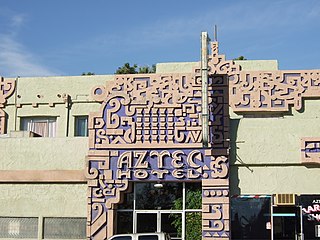
The Aztec Hotel is a historical landmark building in Monrovia, in the San Gabriel Valley, California. The hotel is an example of Mayan Revival architecture still in existence. It was designed by architect Robert Stacy-Judd, and built on U.S. Route 66 in 1925-26. The hotel opened to the public in September 1925, and contained over 40 rooms.

The First Methodist Church of Burlington is a historic church located at 21 Buell Street in Burlington, Vermont. Built in 1869 to a design by Alexander R. Esty, it is the city's only example of ecclesiastical Romanesque Revival architecture. It was listed on the National Register of Historic Places in 1978.
Leon C. Goodrich was an American architect of Casper, Wyoming. A number of his works are listed on the National Register of Historic Places.
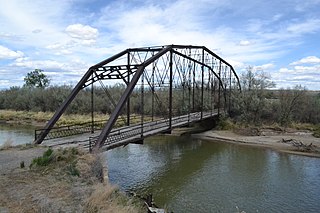
The Rairden Bridge is a Pennsylvania through truss near Manderson, Wyoming, which crosses the Big Horn River. The bridge was built in 1916 by the Monarch Engineering Company. The bridge cost $30,986, making it one of the most expensive bridges commissioned by a Wyoming county government. The bridge was also the longest in Big Horn County's road system at 250 feet (76 m) and is the longest surviving county bridge in Wyoming. In addition, it is one of two Pennsylvania through truss bridges remaining in Wyoming. The bridge was replaced by a new structure and abandoned in 1979.
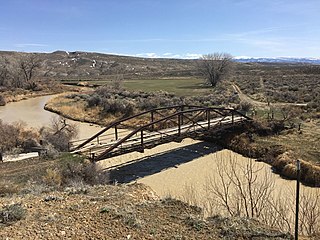
The EJP County Line Bridge is a Camelback pony truss bridge located near Hyattville, Wyoming, which carries Big Horn County Road CN9-60 across the Nowood River. The bridge was built in 1917 by the Monarch Engineering Company. As the bridge was originally thought to connect Big Horn and Washakie Counties, the two counties split the cost of the bridge, with each paying for one abutment and the two splitting the cost of the superstructure; this is the only recorded case of two Wyoming counties purchasing a bridge in such a way. Further surveys determined that the bridge is actually located entirely within Big Horn County. At 102 feet (31 m) long, the bridge is the longest Camelback truss bridge in Wyoming.

The EJE Bridge over Shell Creek is a Warren pony truss bridge located near Shell, Wyoming, which carries Big Horn County Road CN9-57 across Shell Creek. The bridge was built in 1920 by the Midland Bridge Company, the only firm to bid for the bridge contract. At 60 feet (18 m) long, it is the longest known example of a Warren pony truss bridge in Wyoming.

The EJZ Bridge over Shoshone River is a Warren pony truss bridge located near Lovell, Wyoming, which carries Big Horn County Road CN9-111 across the Shoshone River. Contractors McGuire and Blakeslee built the bridge from 1925 to 1926 using a design by the Wyoming Highway Department. The 389-foot-6-inch (118.72 m) bridge has four spans, the second-most of any truss bridge in Wyoming.
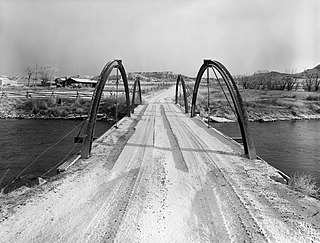
The ELS Bridge over Big Wind River is a pony truss bridge located near Dubois, Wyoming, which carries Fremont County Road CN10-21 across the Big Wind River. The bridge was built circa 1920. Its design is uncommon and merges a kingpost truss with an arched chord. The materials used to build the bridge are also unusual and were likely salvaged; for instance, the arches are made from tunnel sets.

The Basin Republican-Rustler Printing Building is a historic newspaper printing building located at 409 West C Street in Basin, Wyoming. The building was used to print the Basin Republican-Rustler, Basin's weekly newspaper. The Republican-Rustler formed from the merger of two newspapers, the Rustler and the Republican. The Rustler was founded in 1889 in Bonanza and was the first newspaper in the Bighorn Basin; it was published in Hyattville before moving to Basin in 1900. The Republican was first printed in 1905 as a political counterpoint to the Rustler, which had affiliated with the Democratic Party. The two newspapers merged in 1928, four years after the Republican had moved into the Printing Building. The building contains a number of historic printing machines, many of which are still operational; its collection includes linotype machines and an Intertype machine as well as a number of other printing presses and devices used to assemble newspapers.

The Morgan Horse Farm is a historic horse breeding facility at 74 Battell Drive in Weybridge, Vermont. Since 1907, it has been an official breeding site for the Morgan horse, one of the first American-bred horse breeds, and Vermont's official state animal. The breeding program was established in Burlington in 1905, and moved to this site in 1907 by the United States Department of Agriculture, and is now run by the University of Vermont. The farm is listed on the National Register of Historic Places.

The Burlington Traction Company is a historic trolley maintenance facility at Riverside Avenue and North Winooski Avenue in Burlington, Vermont. The property includes two brick trolley barns, built c. 1900 and c. 1910 respectively, that were used as public transit maintenance facilities until 1999, after which they were adaptively repurposed to other residential and commercial uses. The property was listed on the National Register of Historic Places in 2004.
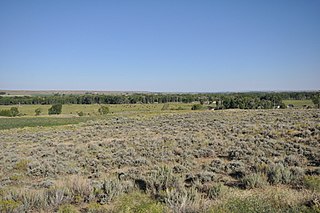
The Ryan Ranch is a 2,000-acre (810 ha) ranch on the east bank of the North Platte River in Carbon County, Wyoming, about 8 miles (13 km) south of Saratoga. One of the oldest ranches in the Platte Valley of central Wyoming, it was founded by Barton T. Ryan in 1874 and expanded by his son Cecil A. Ryan. The ranch headquarters comprises 17 structures arranged around a barnyard. The oldest structure is the 1875 homestead. Other buildings include sheds, shops, guest cabins, barns, trailers and a privy.

The Wells-Richardson Complex is a historic commercial-industrial area in downtown Burlington, Vermont. Bounded by Main, Pine, College, and St. Paul Streets just west of City Hall Park, the architecture on this one city block represents nearly a century's worth of development. It is dominated by the former plant of the Wells-Richardson Company, a highly successful maker of patent medicines in the late 19th century. The district was listed on the National Register of Historic Places in 1979.

The Hotel Higgins, Tabor Hotel or Higgins Hotel was built in 1916-1917 during the oil boom in Glenrock, Wyoming. It was built for John E. Higgins, who was a local rancher, legislator and oil business investor, and his wife Josephine Amoretti Higgins. It was designed by architect Edward Reavill, and it opened on May 9, 1917. After the accidental death of Josephine in 1924 and the death of John in 1926 the property was disputed by their heirs. This was resolved in 1942 when the hotel was sold to Dr. and Mrs. Leonard Tabor at a tax sale, and the hotel became the Tabor Hotel. After several new owners the hotel became the Hotel Higgins again in 1978.
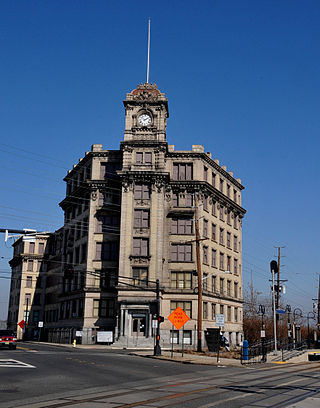
The Philadelphia Watch Case Company Building is located at Pavilion and Lafayette Avenues near the Riverside station in Riverside Township of Burlington County, New Jersey. It was added to the National Register of Historic Places on January 31, 1978, for its significance in architecture, industry, and entertainment.



















